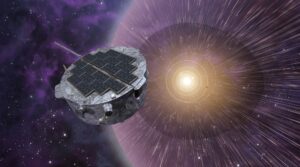WASHINGTON — NASA is developing an updated rideshare policy for science missions that reflects both new launch opportunities as well as challenges faced in accommodating secondary payloads. During a presentation at a meeting last month of the National Academies’ Committee on Solar and Space Physics, Aly Mendoza-Hill, head of the rideshare office in NASA’s Science Mission Directorate, said an update to a rideshare policy for science missions was expected to be released in 2024. The policy dates back to 2018, when Thomas Zurbuchen, associate administrator for science, announced that the agency would use excess capacity on launches of science missions to carry smallsat secondary payloads .
NASA established a rideshare office to coordinate those opportunities in 2020. That “very significant” update, she said, would include other rideshare opportunities. The original policy involved excess capacity on NASA science mission launches, but the new one will include the Venture-Class Acquisition of Dedicated and Rideshare (VADR) contract vehicle as well as other options, such as rideshare launches on NASA Artemis missions and from other government agencies.
“The policy really covers the responsibilities and the costs,” she said. “Every model in that type of rideshare is different. ” The current policy has been used to enable launches of several science and technology demonstration missions.
The Atlas 5 launch of the JPSS-2 weather satellite in 2022 included as a rideshare payload LOFTID, a NASA technology demonstration of an inflatable heat shield. The launch of NASA’s Interstellar Mapping and Acceleration Probe (IMAP) spacecraft on a Falcon 9, scheduled for February 2025, will include NOAA’s Space Weather Follow-On spacecraft and NASA’s Carruthers Geocorona Observatory, a heliophysics mission originally named GLIDE. Another Falcon 9 launch in early 2025 will launch the SPHEREx astrophysics mission as its primary payload with another heliophysics mission, PUNCH, flying as a secondary.
That approach has had some difficulties. IMAP at one point was slated to carry four rideshare payloads. One, NASA’s Solar Cruiser mission, was not confirmed for development.
The other, the Lunar Trailblazer lunar orbiter spacecraft, moved off IMAP to avoid what at the time appeared to be a two-year delay in its launch, with NASA instead acquiring a secondary payload slot on IM-2, the second Intuitive Machines lunar lander mission . Mendoza-Hill suggested that decision may have backfired on the mission. “They may launch before IMAP, maybe not,” she said.
“They’re launching right now six months [early] only. They were initially two years earlier. ” Lunar Trailblazer was one of three missions selected by NASA’s planetary science division through a program called SIMPLEx that planned to use rideshare missions.
The other two, ESCAPADE and Janus, were originally manifested as secondaries on the launch of the Psyche mission. However, a change in mission trajectories led NASA to remove ESCAPADE while Psyche’s 14-month launch delay meant that Janus could not carry out its planned mission. NASA subsequently acquired a launch for ESCAPADE on Blue Origin’s New Glenn rocket using the VADR contract.
That launch, scheduled for late 2024, will be the first flight of that rocket . The agency, though, effectively canceled the Janus mission in July , putting the spacecraft into long-term storage. Unique requirements for NASA science missions, even smallsat missions, can make it difficult to find adequate rideshare opportunities.
“All of our missions are different. They have unique trajectories. They all have different science,” she said.
That rules out the use of launches like SpaceX’s Transporter series, which launches spacecraft to sun-synchronous orbit, or its new Bandwagon line of mid-inclination rideshare launches. The emergence of orbital transfer vehicles, or tugs, could remove some of those constraints, but she argued those vehicles aren’t mature enough yet. “They are just not there, technology-wise.
Hopefully they will be there because that would open up a lot more opportunities for smallsats,” she said. NASA is currently on-ramping new providers for the VADR contract, and Mendoza-Hill said she believed that would include new orbital transfer vehicles, like Blue Origin’s Blue Ring tug that the company publicly announced in October . She discussed at the meeting other challenges with rideshares, such as coupled loads analyses that are needed to ensure that the addition of secondary payloads do not affect the primary payload during launch.
Rideshare payloads also need a greater degree of mission assurance to avoid affecting the primary. “Small missions may have to spend a little more money on mission assurance to take advantage of rideshare to ride along with the higher mission assurance launches,” she said. “It’s not free, but it’s still worth the cost of finding a launch.
”.
From: spacenews
URL: https://spacenews.com/nasa-updating-policy-for-rideshare-missions/



